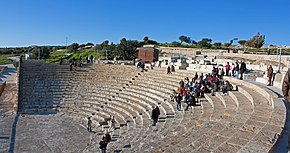Kourion
| Κούριον | |

Kourion Theatre
|
|
| Alternate name | Curium |
|---|---|
| Location | Episkopi, Limassol District, Cyprus |
| Coordinates | 34°39′51″N 32°53′16″E / 34.6642°N 32.8877°ECoordinates: 34°39′51″N 32°53′16″E / 34.6642°N 32.8877°E |
| Type | Settlement |
| Management | Cyprus Department of Antiquities |
Kourion (Greek: Κούριον) or Latin: Curium, was an ancient city on the southwestern coast of Cyprus, the surrounding Kouris River Valley being occupied from at least the Ceramic Neolithic period (4500-3800 BCE) to the present. The acropolis of Kourion, located 1.3 km southwest of Episkopi and 13 km west of Limassol, is located atop a limestone promontory nearly one hundred meters in height along the coast of Episkopi Bay. The Kourion archaeological area lies within the Akrotiri West Sovereign Base Area, which forms part of the British Overseas Territory of Akrotiri and Dhekelia. The Kourion Archaeological Area, and all antiquities within the Akrotiri West Sovereign Base are managed by the Cyprus Department of Antiquity. Kourion is a listed UNESCO World Heritage Site.
Kourion was an urban center of considerable importance within Cyprus, reaching the climax of its influence in the Roman and Late Roman periods. The city is mentioned by several ancient authors including: Ptolemy (v. 14. § 2), Stephanus of Byzantium, Hierocles, and Pliny the Elder. Though Kourion attained its highest prominence under the Romans, the Kouris River Valley has seen occupation from the Ceramic Neolithic period to the present village of Episkopi. Occupation on the acropolis appears to have been from the Late Classical period at latest until the Arab raids of the 7th century CE.
The earliest occupation within the Kouris Valley is the hilltop settlement of Sotira-Teppes, located 9 km northwest of Kourion. This settlement dates to the Ceramic Neolithic period (circa 5500-4000 BCE). Another Ceramic Neolithic hilltop settlement has been excavated at Kandou-Koupovounos, another hilltop situated along the east bank of the Kouris River. In the Chalcolithic period (3800-2300 BCE) settlement shifted to the site of Erimi-Pamboules, located within the limits of the village of Erimi. Erimi-Pamboules was occupied from the conclusion of the Ceramic Neolithic through the Chalcolithic period (3400-2800 BCE).
...
Wikipedia

